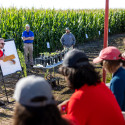Wisconsin, Morgridge scientists excise vector, exotic genes from induced stem cells
A team of scientists from the Morgridge Institute for Research at the University of Wisconsin–Madison reports that it has created induced human pluripotent stem (iPS) cells completely free of viral vectors and exotic genes.
By reprogramming skin cells to an embryonic state using a plasmid rather than a virus to ferry reprogramming genes into adult cells, the Wisconsin group’s work removes a key safety concern about the potential use of iPS cells in therapeutic settings.
The new method, which is reported in today’s (March 26) online issue of the journal Science, also removes the exotic reprogramming genes from the iPS equation, as the plasmid and the genes it carries do not integrate into an induced cell’s genome and can be screened out of subsequent generations of cells. Thus, cells made using the new method are completely free of any genetic artifacts that could compromise therapeutic safety or skew research results, according to the Science report.
The new work was conducted in the laboratory of James Thomson, the UW–Madison scientist who was the first to successfully culture human embryonic stem cells in 1998 and, in 2007, co-discovered a way to make human-induced pluripotent stem cells. Thomson, a professor in the UW–Madison School of Medicine and Public Health, is also the director of regenerative biology for the Morgridge Institute for Research, the private, nonprofit side of the new Wisconsin Institutes for Discovery at UW–Madison.
“We believe this is the first time human-induced pluripotent stem cells have been created that are completely free of vector and transgene sequences,” says Thomson.
The new study was led by geneticist Junying Yu, the Wisconsin researcher who, with Thomson, co-discovered a method for reprogramming adult skin cells to behave like embryonic stem cells, the master cells that arise at the earliest stages of development and that ultimately develop into all 220 cell types in the human body.
While the methods first devised for reprogramming adult cells yielded embryonic-like cells, the process resulted in the permanent integration of both viral genes and the genes used for reprogramming into the genomes of the newly induced cells. Such genetic baggage posed safety concerns for potential therapies like cell transplants, and confounded work in the lab, as the introduced genes sometimes spurred mutations that interfered with the normal function of induced cells.
The new work was accomplished using a plasmid, a circle of DNA, and cells from the foreskins of newborns. “The plasmids carry all the needed transgenes, but don’t integrate into the host DNA, they just float around as episomes” in the cell, Thomson says.
The plasmids replicate, but they do so somewhat inefficiently, Thomson explains, so that after they perform the job of reprogramming, they can subsequently be weeded out, leaving the induced cells free of any exotic genetic material. “Once the transgenes have done their job and are no longer needed, one can merely recover induced pluripotent stem cells that have lost their episomes.”
The resulting cells, says Thomson, are remarkably similar to embryonic stem cells and show the same capacity to proliferate indefinitely in culture and diversify into all the cell types of the human body.
“The recent discovery that adult cells could be reprogrammed to iPS cells that resemble embryonic stem cells opened up tremendous potential for regenerative medicine,” says Marion Zatz of the National Institute of Health’s National Institute of General Medical Sciences, which partially funded the new work. “However, the early methods posed significant risks in using iPS cells in a clinical setting. This latest discovery by Thomson’s group of a new method for generating iPS cells without inserting viral vectors into the cells’ genetic material is a major advance toward safely reprogramming cells for clinical use.”
Thomson notes that researchers have developed other promising approaches using mouse cells, and previously had removed most of the vector and exogenous gene sequences from human-induced pluripotent stem cells. However, those efforts did not succeed in removing all of the genetic artifacts of reprogramming, which could still result in mutations in induced cells.
“Given the rapid pace of the field, it won’t be surprising if there are several alternative methods for producing vector and transgene free cells very soon,” says Thomson. “However, it will be essential to determine which of these methods most consistently produces induced pluripotent stem cells with the fewest genetic abnormalities. Any problems would impact research, drug development and possible transplantation therapies.”
The new viral vector-free iPS cells will be available to researchers almost immediately through the International Stem Cell Bank at the WiCell Research Institute, which also carries the four original iPS cell lines developed by the Thomson lab in 2007.




